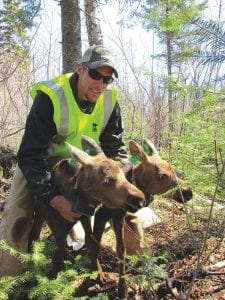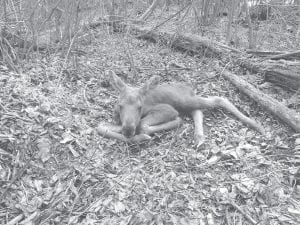A crew from Alaska has been working with the Minnesota DNR to capture and collar 50 moose calves this spring in the Arrowhead Region. To date the crew has captured and collared 11 sets of twins, a number that far exceeded the normal birth rate of twins for this area. Researchers want to know why 2/3 of the calves die within the first year of their birth, and the collars will send them data on the babies as they grow.

As part of its study to determine what is causing the steep decline in the moose population in northeastern Minnesota, the Minnesota Department of Natural Resources (DNR) has begun radio collaring 50 moose calves.
The collars placed on the young moose hold GPS trackers and transmitters that send back information (heart rate, air temperature, etc.) to researchers every 20 minutes. If a moose doesn’t move for six hours—twice its normal naptime—researchers assume it has died and go retrieve it to bring back to study in their St. Paul lab.
Scientists want to know why three-quarters of the area’s moose calves are dying within a year of birth, a number that is unsustainable to maintain the moose population in northeastern Minnesota.
To date 28 calves have been captured and collared, and three have died. Researchers give the cow and calf at least 36 hours to bond before they separate them and collar the baby.
“One died on its own,” said Glenn DeiGiudice, PhD research scientist/moose project leader, Forest Wildlife Populations and Research Group, MNDNR. “We don’t know why yet.

As part of the DNR’s effort to find out what is killing moose in Minnesota, the DNR is outfitting 50 calves (like the one above) with radio collars that will send back pertinent information to scientists studying their movements. It is estimated that two-thirds of calves die before their first birthday and researchers want to know why.
“They might have all died from starvation and the bad weather, we’re not sure, but one thing we have found in all three is that none of them had milk or colostrum in their G.I. tract,” DeiGiudice.
DeiGiudice is in charge of the calf project, which he said is the most detailed moose calf mortality study he had ever worked on.
“We know less about calf mortality then adult mortality,” said DeiGiudice.
One surprise early on is the number of twins born this spring.
“So far the project is going very well. We have captured 11 sets of twins, a much higher percentage than we thought we would find,” said DeiGiudice.
Researchers began capturing and collaring the youngsters on May 8 in the Arrowhead Region.
In January 2013, the DNR radio collared 111 adult moose. About half of those were females.
“We will be using location data from the cows’ collars to identify when they have calved [they make a large movement to a calving site and then localize for 7-10 days],” said Erika Butler, D.V.M. wildlife veterinarian of Natural Resources for the DNR.
Butler said the goal was to “catch calves between 1-4 days of age.”
“We have been getting some interesting observations on our cows— including quite a bit of hair loss [associated with ticks] and reports that some are very skinny. I think the cows have been struggling to find good browse, but now that the snow is gone, things should be getting much easier for them,” Butler said.
DeiGiudice said that one cow “was 80 percent hairless, and many are in pretty ragged condition.”
He said the cows that had twins tend to be in better condition. “Cows that have twins tend to weigh more in the fall and go into the winter healthier than cows that give birth to one calf,” explained DeiGiudice.
Since 2007 the moose population in northeast Minnesota has fallen from 8,860 to 2,760 in 2012. Last year 35 percent of the population died, but why? So far theories include global warming, lack of proper vegetation, ticks that carry diseases, mosquitoes carrying viruses, brain worm, liver flukes, predation by wolves and bear or a combination of these things and maybe some great unknown.
To date 13 of the 111 adult moose captured and collared in January have died. Necropsies conducted in the lab and in the field have been performed to see what has caused them to die.
“Four were capture related, four were wolf kills, one was from a wolf bite with secondary bacterial infection that killed it, one had brain worm with a worm in its eye and three were health-related but results are pending. One was likely due to winter ticks—lots of hair loss, possible exposure,” said Butler.
“So far our technology has been functioning fantastically. We have been getting notifications in a timely matter and we have been able to respond like we had hoped,” Butler said.
Part of this wide-ranging study includes the capture of 54,319 mosquitoes (skeets) representing 29 species collected from Cook County and sent to the Minnesota Department of Health where they are being tested for Eastern Equine Encephalitis (EEE) and West Nile Virus (WNV). The captures took place last summer and fall, right up until freeze-up.
“We have gotten results back on our first two batches of ‘skeets.’ They were all negative for EEE and WNV (West Nile Virus). Like I’ve mentioned before, finding a positive is like finding a needle in a haystack, but we have quite a few pools to get through yet,” said Butler.


Loading Comments